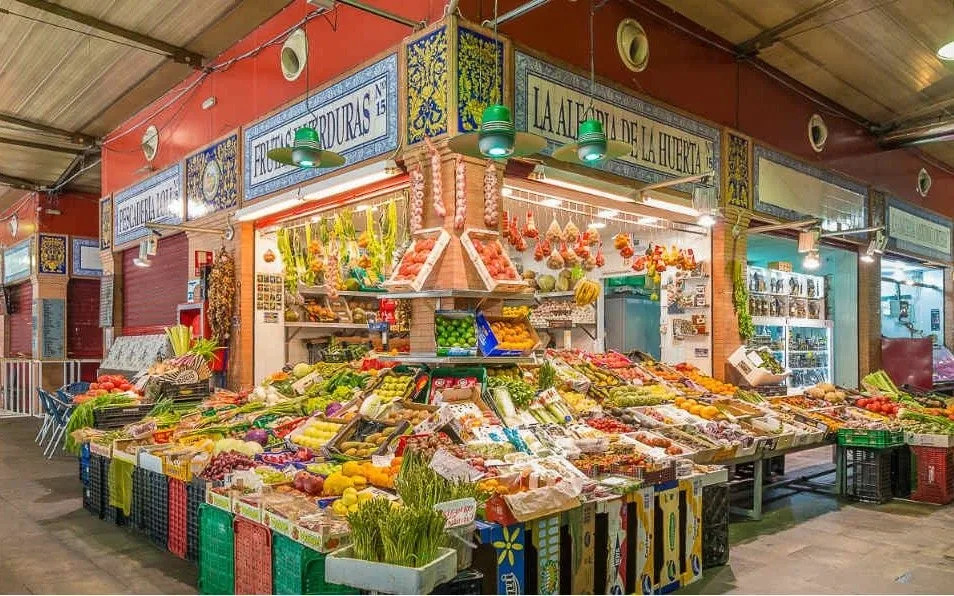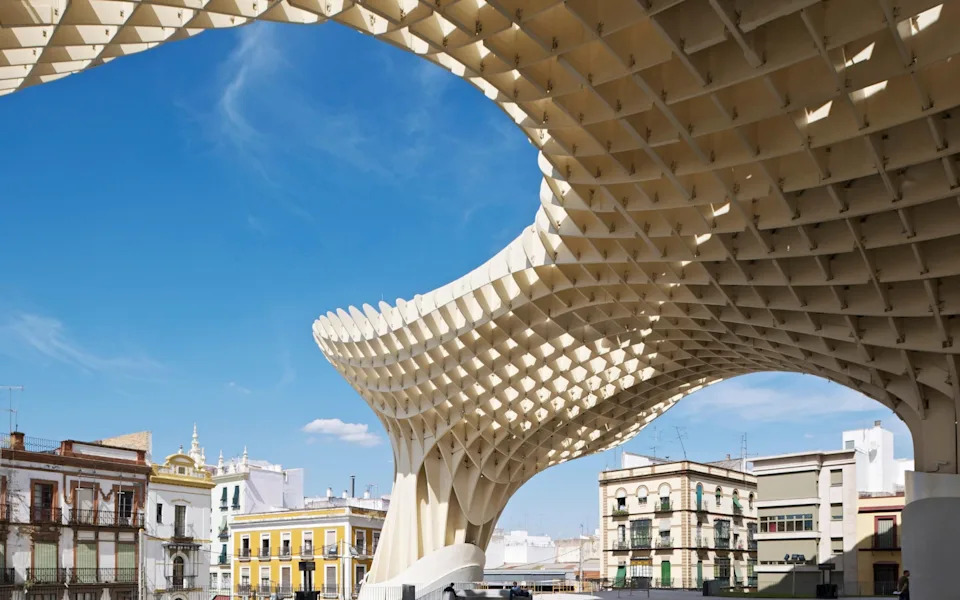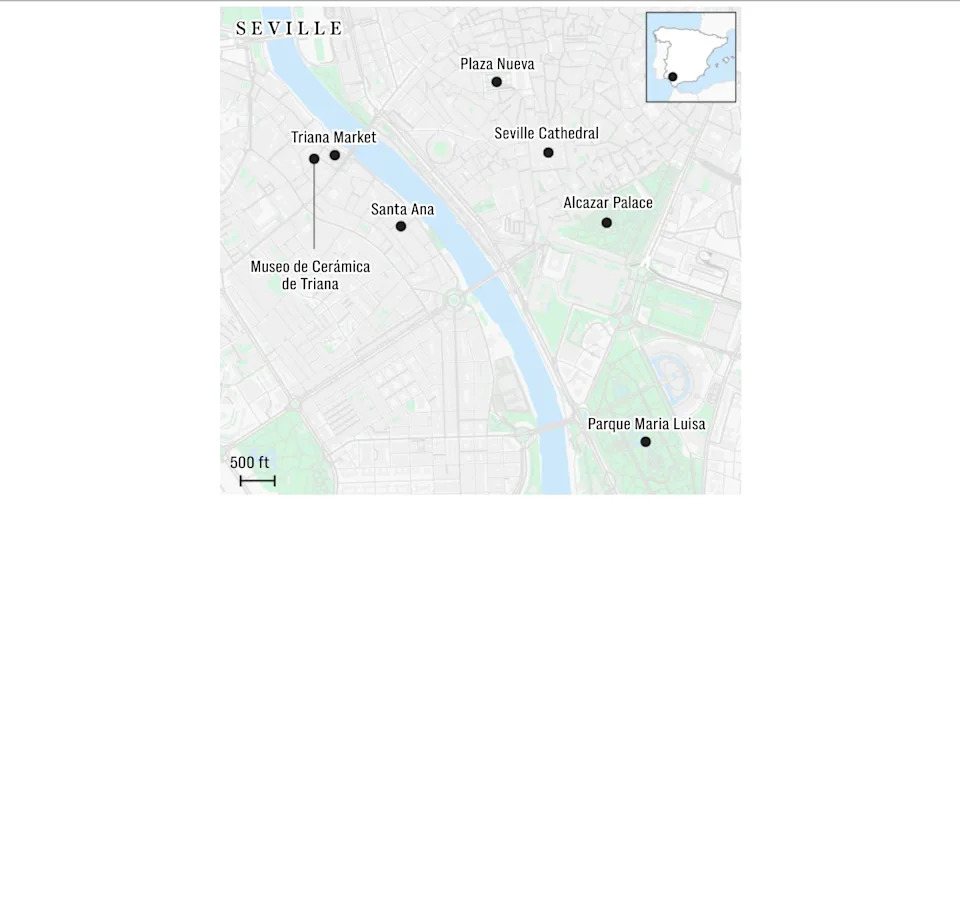
Known for its steamy-hot summers, mild winters and sultry operatic gypsy heroine Carmen, Seville is a bijou city whose fabulous food, extraordinary Mudejar, Gothic and Renaissance architecture, and exotic flamenco rhythms never fail to charm and seduce. History oozes through its pores, with ancient Moorish walls, Roman ruins and Baroque churches at every turn.
Follow the locals to hole-in-the-wall bars, sip cañas (small glasses) of beer, and then get lost wandering the tiny streets of Barrio Santa Cruz, dotted with orange-tree-filled plazas, before resting in a quiet, shady corner on a tiled bench. For a more authentic experience, head to boho Macarena or tile-and-gypsy quarter Triana. Then, after dusk, head up the rooftops to admire the largest Gothic cathedral in the world and its Moorish-Christian tower from a terrace bar.
For further Seville inspiration, see our in-depth guides to the city’s best hotels, restaurants, bars, things to see and do, and things to see and do for free. If planning a longer trip, discover our ultimate itinerary in Andalusia here.
In this guide:
What’s new in Seville this season
How to spend your weekend
When should I visit Seville?
Where to stay in Seville
What’s new in Seville this summer
Experience
Sacred art exhibition at Castillo de San Jorge
Admire artisan pieces from Seville’s Semana Santa processions at the medieval Castillo de San Jorge, until late August – from lifelike wooden images and elaborate silver floats to carved candles and exquisitely embroidered velvet canopies. I also loved the Divina Pastora’s (Holy Shepherdess) gold lace bonnet and the wax petal installation.
Stay
Casa del Limonero
A winning combination of magnificent 15th-century palace, tranquil garden and swimming pool, plus a stunning contemporary art collection. Casa del Limonero is Santa Cruz’s intriguing new boutique hotel opening. Sit on a Jacobsen Egg chair, see captivating Malick Sidibé portraits and then float in a sea-green mosaic-tiled pool.
Eat
Augurio
A women-led team brings the finest catch and the warmest service to centrally located Augurio. As always, the delectably tender, juicy atún de almadraba (sustainably caught bluefin tuna) is best appreciated raw as tartare, paired with a rich Amontillado sherry.
AdvertisementAdvertisement#«R4iekkr8lb2m7nfblbH1» iframe AdvertisementAdvertisement#«R8iekkr8lb2m7nfblbH1» iframeReturn to index
How to spend your weekend
Day one: morning
Be swept back in time to King Pedro the Wise’s Mudejar (Christian-Moorish) royal court at the 14th-century Alcazar Palace, with its exquisite ceramic tiles and heavenly gold ceilings. Explore the gardens, home to peacocks, pavilions and pools. Look familiar? You may have seen it as the Water Gardens of Dorne in Game of Thrones.
In summer, outdoor night-time concerts are held here, probably Seville’s most magical venue, with the grutesco stone wall as a backdrop as moonlight streams through the palm trees. Note that tickets are collected from the office in the Patio de Banderas, not at the main entrance; entry is free on Monday afternoons. Find more of the city’s best attractions here.
 The 14th-century Alcazar Palace is home to gardens, pavilions and pools - tupungato/Getty Images
The 14th-century Alcazar Palace is home to gardens, pavilions and pools - tupungato/Getty ImagesThen cross Plaza del Triunfo and be wowed by Seville Cathedral, the third-largest in the world. The basilica’s scale is jaw-dropping, with a 130ft-plus-high nave and 80 chapels. Be sure to climb up the Giralda belltower, formerly the minaret of the mosque which stood here, for fabulous views over Barrio Santa Cruz. For lunch, reward yourself with some divine modern tapas at nearby La Azotea – try tuna tacos with guacamole or filo parcels of cream cheese, leek and prawns.
Afternoon
Head down Calle San Fernando, stopping off at the Royal Tobacco Factory, one of the settings for Seville’s famed Carmen – spot the head of Colon (Christopher Columbus) on the entrance – and stroll on to Parque Maria Luisa, home to pretty tiled benches, shady corners named after love poets, and magnificent Plaza de España.
AdvertisementAdvertisement#«R4tekkr8lb2m7nfblbH1» iframe AdvertisementAdvertisement#«R8tekkr8lb2m7nfblbH1» iframeThis vast brick structure, built for the 1929 Expo, is a photographer’s dream, with its wide plaza, elliptical walls, and colourful ceramics and flowers. Look out for the statue of architect Anibal Gonzalez, gazing at his creation.
 Plaza de España, found in the Parque Maria Luisa, was built for the 1929 Expo - doble.d/Getty Images
Plaza de España, found in the Parque Maria Luisa, was built for the 1929 Expo - doble.d/Getty ImagesLate
One of Seville’s slickest restaurants, Seis, in central Plaza Nueva, ticks all the boxes for décor (jungle-themed with myriad trailing tendrils), service (efficient, friendly staff), and food (modern Mediterranean-Asian), as well as offering superb value. Start off with a cucumber margarita at the lively bar (you’re under a tree canopy). Then slide into a cosy booth for Peruvian sea bass ceviche or an Iberian pulled pork hotdog.
Finish off your evening at rooftop bar EME Catedral Mercer Terraza, where you can mingle with the smart crowd, and sip a mojito at eye level with some gravity-defying flying buttresses.
Day two: morning
Head over the river to the bohemian, sailor and ceramic tile neighbourhood of Triana. Start off with a visit to the Museo de Cerámica de Triana, which explains about this local industry, including the famous azulejos (glazed tiles), stretching back centuries – you’ll have seen sumptuous polychromatic examples already, in the Alcazar Palace and around the city.
AdvertisementAdvertisement#«R55ekkr8lb2m7nfblbH1» iframe AdvertisementAdvertisement#«R95ekkr8lb2m7nfblbH1» iframeThen pop next door and absorb the sights, smells and sounds of Triana Market, replete with fresh local produce – don’t miss the fabulous fish stalls, with scary-looking seafood, or skilled jamon-carvers. Saunter down calle Pureza to Seville’s oldest parish church, Santa Ana, built in 1266.
Look out for the painting of Santa Rufina and Santa Justa, Christian martyrs who were potters from Triana; the city’s patron saints, they’re pictured with the Giralda, which they saved from an earthquake, according to local legend. Find more of the best free things to do in the city here.
 The Triana Market is full of local produce
The Triana Market is full of local produceAfternoon
Back over the river, down an unprepossessing back street near the Setas, is the sublime Palo Cortao. A haven for sherry-lovers (hence the name), this place has more than 60 vinos de Jerez, from dry, pale finos to golden, nutty olorosos. The seasonal menu tends towards seafood, with daily fish and rice specials; for carnivores, a pulled pork brioche, while vegetarian fare might feature sweet potato gnocchi with almond and truffle sauce.
Owners Anna (front of house) and Angel (chef) and their excellent team tend to diners on the small terrace and inside. Find more of the city’s best restaurants here.
AdvertisementAdvertisement#«R5cekkr8lb2m7nfblbH1» iframe AdvertisementAdvertisement#«R9cekkr8lb2m7nfblbH1» iframeOver on the Alameda de Hercules, centre of bearded hipster-dom, go up to rooftop bar at the Corner House for a bird’s eye view of alternative Seville – the terrace offers an unpretentious, laid-back vibe; Aperol spritz is the drink of choice.
 Enjoy an Aperol spritz in Seville - Martin Schütz/Getty Images
Enjoy an Aperol spritz in Seville - Martin Schütz/Getty ImagesLate
Head to Flamenco Esencia at Taberna La Quedá de Triana, just off Calle Betis, which has authentic flamenco shows on an intimate scale – the performers are swishing their skirts inches from your face. You might even see a neighbour joining in spontaneously, in the true spirit of flamenco. Have a beer (you get one with your ticket) , or go on a tapas tour with a dancer, learn about flamenco, and finish up at the show.
Then head down Calle Betis to Embarcadero, a nautical-feel bar with tables almost on the water. Alternatively, if you feel inspired to take to the floor yourself, go back towards Triana Bridge to Lo Nuestro, where locals practise Sevillanos, a local version of flamenco performed in pairs at the Spring Fair, to live music all year round. A gin-tonic will give you the Dutch courage you need. Find more of the city’s best bars here.
 Seville’s historical centre is home to ancient Moorish walls, Roman ruins and Baroque churches - alxpin/Getty Images
Seville’s historical centre is home to ancient Moorish walls, Roman ruins and Baroque churches - alxpin/Getty ImagesReturn to index
When to go
Spring and autumn are the best times to visit the city, when the daytime temperatures are warm, with mild evenings. The city comes to life for Semana Santa (Holy Week) in March/April, followed by Feria two weeks later – the sherried-up, frilly-dress-and-dancing party in a fairground to the south of the city.
AdvertisementAdvertisement#«R5nekkr8lb2m7nfblbH1» iframe AdvertisementAdvertisement#«R9nekkr8lb2m7nfblbH1» iframeIn summer, the afternoons and evenings are sweltering, with siestas a must and a pool for cooling dips advisable, while winter days can be cool and rainy. But the sun shines (almost) all year round, so you’re virtually guaranteed blue skies and amazing light.
 The Metropol Parasol ticket gives you two visits; don’t miss the nighttime light show, or a short film on a vast, curved screen. - Universal Images Group Editorial
The Metropol Parasol ticket gives you two visits; don’t miss the nighttime light show, or a short film on a vast, curved screen. - Universal Images Group EditorialReturn to index
Where to stay
Luxury living
The magnificent Hotel Alfonso XIII, which is framed by palm trees, is a much-loved piece of Seville’s history. With lamps bearing crowns and regal beds, you could say it’s fit for a king or queen.
Read our full review here.
Designer digs
Triana House comprises an uber-chic hotel with b&b next door, located in trendy yet down-to-earth Triana. The small but well-appointed rooms boast classy décor by Seville’s most-wanted designer. Clever extras include a stylish booklet with well-chosen tips on where to eat and shop.
AdvertisementAdvertisement#«R62ekkr8lb2m7nfblbH1» iframe AdvertisementAdvertisement#«Ra2ekkr8lb2m7nfblbH1» iframeRead our full review here.
Budget beauty
The great-value U-Sense Centro is a small hotel hidden away on a winding alley in the warren of the Santa Cruz Old Town, only yards away from the Cathedral and La Giralda. It’s simple but smart and contemporary, and staff are wonderfully courteous and helpful.
Read our full review here.
See more hotels in Seville.
Return to index
Know before you go
The basics
Currency: Euros €
Telephone code: 0034 954/955
Time difference: GMT +1
Flight time: Around two and a half hours from London
Essential contacts:
British Consulate (00 34 952 35 23 00; gov.uk), Calle Mauricio Moro Pareto 2, Edificio Eurocom, 29006 Malaga, Spain.
Police: 091
Ambulance: 112
Tourist Office: Plaza del Triunfo 1, Sevilla, Spain; 00 34 954 210 005

Local etiquette
Seville is a relaxed city, but the biggest difference between southern Spain and Britain is the timing of meals. Lunch doesn’t happen for most until at least 2pm – although these days some places open as early as 12.30pm – or 9.30pm for dinner (some places at 8pm). If you eat early, be prepared to sit in a quiet restaurant without locals or a buzzy atmosphere.
In terms of dress code, shorts are fine, though as anywhere, in smarter restaurants, trousers or a skirt is more acceptable. In the cathedral, the following clothes are not allowed: micro-shorts/hot pants, miniskirts or strapless tops (women); vest tops (men); hats such as sun hats and baseball caps; and flip-flops.
Public transport, including the tram and metro, is excellent. Although if you’re staying in the centre, you’re unlikely to need it, as you can walk everywhere. It is very affordable per trip, with one or three-day passes also available.
Cabs are easy to find (white and yellow), with ranks outside luxury hotels and many attractions. They are well priced, and a ride within the historic centre (the area inside the ring road) won’t break the bank. Uber and Cabify also both operate in Seville.
Tipping is not expected, and there is no service charge, although some restaurants have a cover charge for bread. A tip of around 10 per cent in a restaurant will be gratefully received.
About our expert
Fiona Flores-Watson is The Telegraph’s Seville destination expert.
AdvertisementAdvertisement#«R6lekkr8lb2m7nfblbH1» iframe AdvertisementAdvertisement#«Ralekkr8lb2m7nfblbH1» iframe“I have lived in this historic, flamboyant Andalucian city since 2003. As a city guide, I revel in visitors’ reactions – jaws dropping in wonder – at its delights, such as the world’s largest Gothic Cathedral and the resplendent Plaza de España.”
 Fiona Flores Watson, Telegraph Travel’s Seville expert
Fiona Flores Watson, Telegraph Travel’s Seville expertBroaden your horizons with award-winning British journalism. Try The Telegraph free for 1 month with unlimited access to our award-winning website, exclusive app, money-saving offers and more.
This expert guide to planning the perfect weekend in Seville this summer is an indispensable resource for travelers seeking authenticity, culture immersion and a taste of Spanish hospitality like no other.
Experience the charm and sophistication of Seville summer weekends like an expert with this comprehensive guide – a must-read for travelers seeking unique experiences in Andalusia!
Seize the sunshine this summer and discover how to make your weekend in Seville unforgettable with 'An expert guide'. The city's historic charm, delicious tapas culture & breeze offuring promenade reimagined as a must-experience getaway for travelers seeking authenticity.
Discover the ultimate escape plan for a perfect weekend in Seville this summer with our expert guide – guaranteed to turn your vacation into an unforgettable experience.
An expert guide to the perfect weekend in Seville this summer reveals a wealth of tips and insights for creating an unforgettable experience, packed with flavors from Flamenco nights under Andalusia's starry skies.














